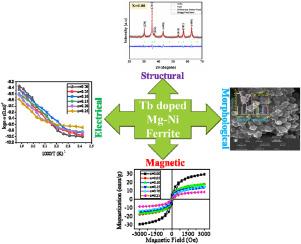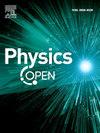自旋电子应用中稀土(Tb3+)离子取代Mg-Ni纳米晶铁氧体的结构、电学和磁各向异性研究
IF 1.4
Q2 Physics and Astronomy
引用次数: 0
摘要
采用溶胶-凝胶自燃烧法合成了化学式为Mg0.2Ni0.8TbxFe2-xO4 (x = 0.00 ~ 0.25)的Tb3+离子掺杂Mg-Ni纳米晶铁氧体。用x射线衍射、红外光谱和紫外可见光谱分析了所有样品的结构特性。XRD研究证实,在x = 0.15至更高浓度的样品中存在二次相。随着Tb3+离子的增加,晶格常数减小,x射线密度增大。在FTIR光谱中观察到的两个突出的吸收带证实了尖晶石结构。紫外-可见研究得到的直接带隙在1.85-1.67 eV范围内,证实了半导体行为。FESEM计算的晶粒尺寸随着Tb3+浓度的增加而增大。直流电导率测量也表明了样品的半导体特性。磁测量采用VSM进行。Tb3+离子的加入使饱和磁化强度从29.32 (x = 0.00)降低到8.61 (x = 0.25) emu/g。此外,各向异性常数和各向异性场均随着Tb3+离子含量的增加而减小。可调磁软化,半导体性质和各向异性控制是必不可少的裁剪材料自旋电子应用。本文章由计算机程序翻译,如有差异,请以英文原文为准。

Investigation of structural, electrical, and magnetic anisotropy studies of the rare earth (Tb3+) ion substituted Mg-Ni nanocrystalline ferrites for spintronic applications
Tb3+ ion-doped Mg-Ni nanocrystalline ferrites with the chemical formula Mg0.2Ni0.8TbxFe2-xO4 (x = 0.00 to 0.25) were synthesized using the sol-gel auto-combustion method. The structural properties of all samples were analyzed using X-ray diffraction, FTIR, and UV–visible spectroscopy. XRD studies confirmed the existence of a secondary phase in samples with x = 0.15 to higher concentrations. The lattice constant decreased, and the X-ray density increased with increasing Tb3+ ions. The two prominent absorption bands observed in the FTIR spectra confirmed the spinel structure. The direct band gap obtained from the UV–vis investigation was in the range of 1.85–1.67 eV, confirming semiconducting behavior. The grain size calculated using FESEM increased with increasing Tb3+ concentration. DC electrical conductivity measurements also indicated the semiconducting characteristics of the samples. Magnetic measurements were performed using VSM. The addition of Tb3+ ions resulted in a decrease in the saturation magnetization from 29.32 (x = 0.00) to 8.61 (x = 0.25) emu/g. In addition, the anisotropy constant and anisotropy field decreased with increasing Tb3+ ion content because of secondary phase formation. Tunable magnetic softening, semiconducting nature, and anisotropy control are essential for tailoring materials for spintronic applications.
求助全文
通过发布文献求助,成功后即可免费获取论文全文。
去求助
来源期刊

Physics Open
Physics and Astronomy-Physics and Astronomy (all)
CiteScore
3.20
自引率
0.00%
发文量
19
审稿时长
9 weeks
 求助内容:
求助内容: 应助结果提醒方式:
应助结果提醒方式:


